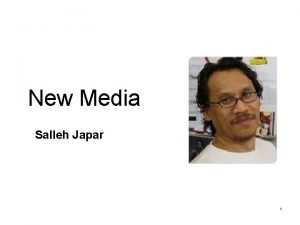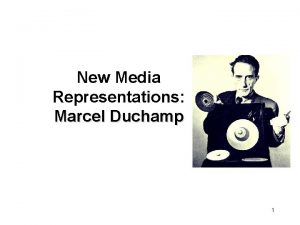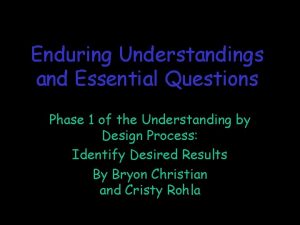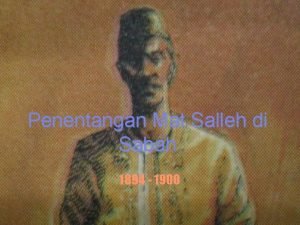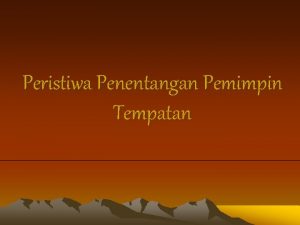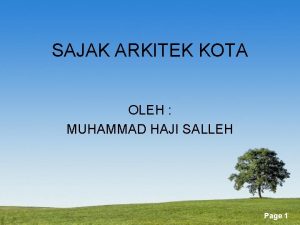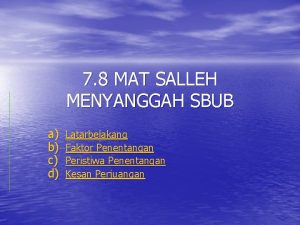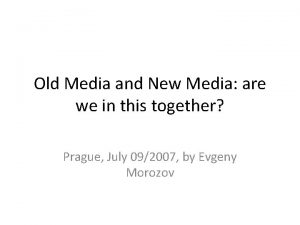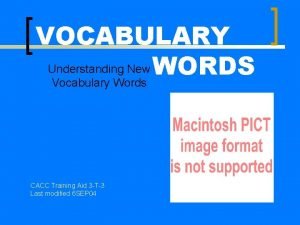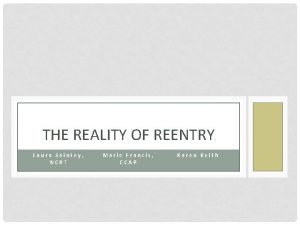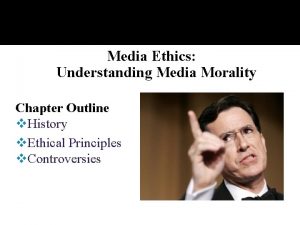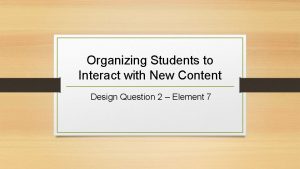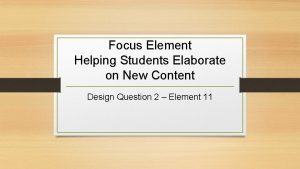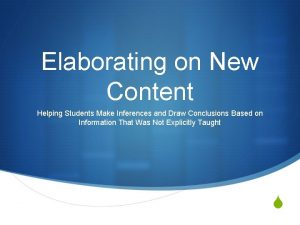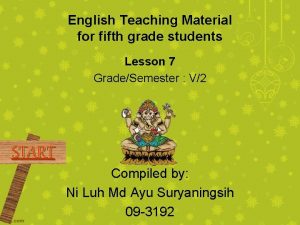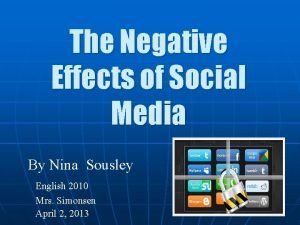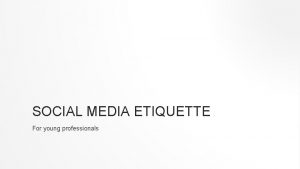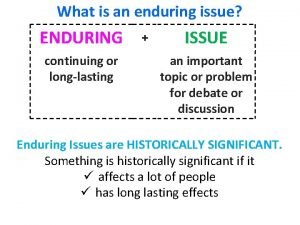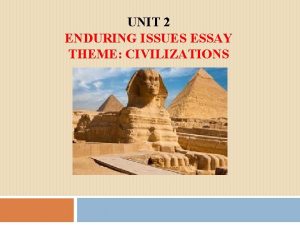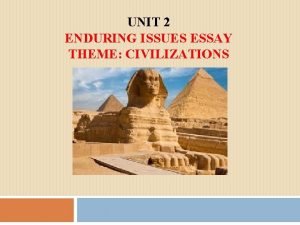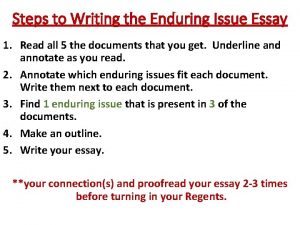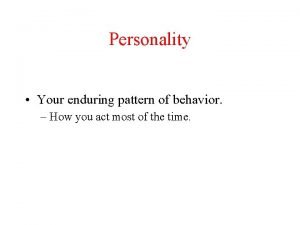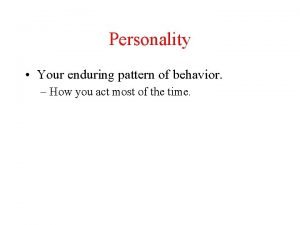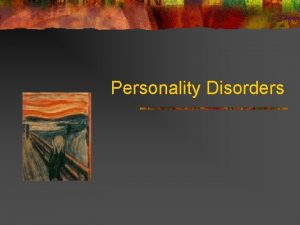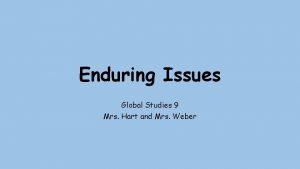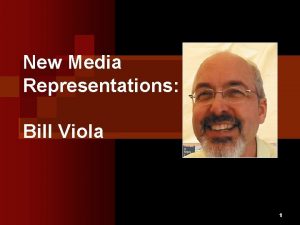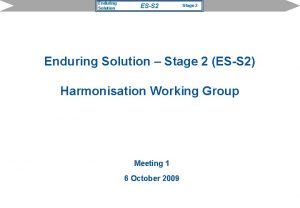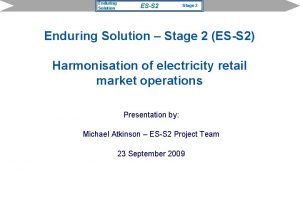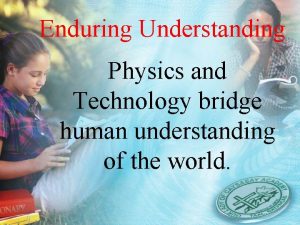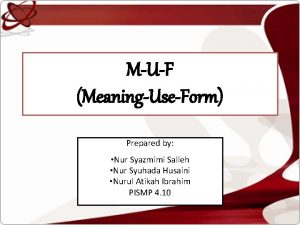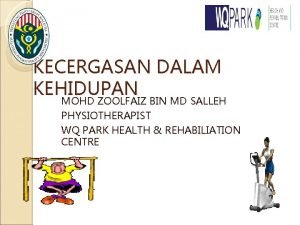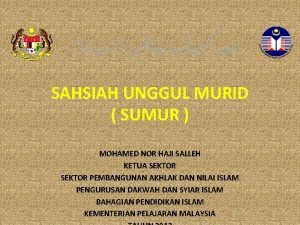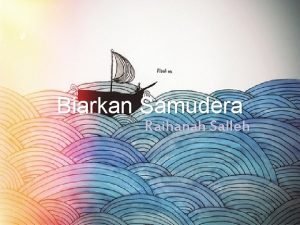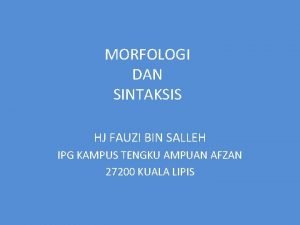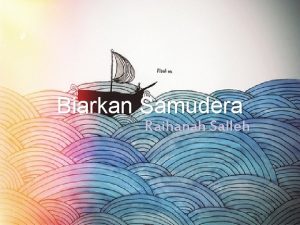New Media Salleh Japar 1 Enduring Understanding Students
































- Slides: 32

New Media Salleh Japar 1

Enduring Understanding Students will understand that the use of readymades and other media have created new approaches to art and expanded its definition. 2

Essential Questions Overarching Questions 1. What is the extent of the influence of technology in art? 2. How has new media push the boundaries of art making? 3. Are there challenges to such approaches to art making? Topical Questions 1. What is symbolism? 3

5 W 1 H When 1963 - How Installation Mixed Media Ready Mades Why Where Singapore Salleh Japar Which Contemporary Islamic Influence His Personal Views What On Knowledge & Symbols 4

Biographical Outline Education and employment Salleh began his art training in 1983 at the Nanyang Academy of Fine Arts (NAFA). Here, he met S. Chandrasekaran and Goh Ee Choo, and they became known in the academy as the "three bad boys". These selfconfessed rebels boycotted their graduation show in 1988, choosing instead to hold an independent exhibition at the Goethe-Institut entitled Trimurti. Salleh had graduated from the academy in 1986 with a Diploma in Fine Arts. He entered the Curtin University of Technology, Australia in 1989 to continue his art education, returning with a Bachelor of Fine Arts (Distinction) the following year. Upon return, he became a lecturer in art history at NAFA and remained here until 1995. During this period, he was also an Assistant Curator of Art for the National Museum of Singapore. He then left Singapore again to further his studies at the University of Central England, United Kingdom and graduated with a Postgraduate Diploma in Art Education in 1995. He has been teaching at the LASALLE College of 5 the Arts since 1996.

When & Where 1965: Independence of Singapore. 1979: Economic restructuring with expansion of technology. Educational policies are thus changed Singapore The emergence of new media artists. 6

Which Contemporary Art- by Tate q Art of the present day. q Art of the rather recent past. q Art that is innovative or avant-garde in characteristics. q When did it start? The date varies. Contemporary Art- by Art. Lex q Art that is current. q Art that belongs to the same period of time- current. 7

What Subject Matter • Anything that pertains to specific works. • He uses symbols, religious or non-religious. Theme q. Problem of knowledge and how it is being produced in Singapore. q. Self-identity, discovery and review. q. Ideologies from other religious groups. Buddhism, Hindusim and Taoism, eg: Trimurti. 8

What q Some notions from Sufi tradition- on “the importance of the present”, as compared to the past (equates to nothing) and the future (equates to unpredictability which may never arrive). q Culture and sense of identity as a Singapore Muslim- as seen by some critics. q “Salleh wishes to position the artist within the sphere of Muslim values” (Sabapathy, 1998) leading to the rejection of the claim that all artists are creators. 9

2 -Dimensional works Untitled, 1987 10

2 -Dimensional works Fitrah (Human Nature) , 1988 Mixed media, 219 x 175 cm SAM, Singapore. 11

What- Fitrah (Human Nature) q q q The image at the centre is a derivation from the pall (blanket/shroud) cover that is used to cover the Muslim coffin. It is used as a symbol to represent the “microcosmic” self. It is about life in the universe as a spiritual journey 12

2 -Dimensional works Thought Out of Season, 1988 Mixed media, 170 x 163 cm Artist’s Collection 13

2 -Dimensional works Gunungan II, 1989 -90 14

Assisted Readymade Works Box: Elements (Water, Wind, Fire), 1987 15

Assisted Readymade Works Creation, Trimurti, 1988 Installation, 420 x 210 cm 16

What- Trimurti A work by Salleh Japar and two other artists S. Chandrasekaran and Goh Ee Choo. q q The word ‘Trimurti’ is Sanskrit- meaning three forms that are connected to the “Hindu Godhead of Brahma, Vishnu and Siva. ” q In this work, the word is used to describe three forces of nature. Creation, Preservation and Destruction (parts of the cosmic cycle). q Each force co-exists to create a total concept using paintings, sculptures, installation and performance. q It is site- specific- the space was taken into consideration- to create not only an art space but also a space that radiates energy. 17

What- Trimurti q The three artists take- language of art is a universal language. q Hence the purpose is to use this universal language to show that “different things can exist together harmoniously and in perfect equilibrium”. q This is seen in the artists’ differing cultural backgrounds- a Malay, an Indian and a Chinese, and religious background. Muslim, Hindu and Buddhism/Taoism. q And that they come together and created a total work the runs like a cycle. 18

What- Trimurti q Destruction by Chandrasekaran The artist tears apart a pre-installed work during the opening of the exhibition. q Creation by Japar The artist create an installation with the fragments of Chandrasekaran’s destroyed work. q Preservation by Goh The artist preserved and sustain his installation which was born out of Japar’s installation. 19

Installation Crossroads II, 1990 20

Assisted Readymade Mechanised Learning, 1993 Mixed Media, 95 x 170 x 51 cm 21

Installation Born Out of Fire, 1993. Installation NHB Collection 22

Installation Drip Machine, 1993 -94 Installation 23

What- Drip Machine q q q The gowns bear the hand-written texts by the artist. They are quotations taken from a book by an Indonesian writer known as Hamka advocates that the pursuit of modern knowledge should be accompanied with ethics and morality. Infusion bottles hang over the gowns as liquid drips onto them, washing off and dissolving the text into a long metal tray beneath the gowns. A tube runs from the trays to a cast head (the same one in Mechanised Learning), a symbol of a mind that has been colonised. 24

What- Drip Machine q The endeavours of post-colonial territories should take the direction of unlearning habits imposed by the colonial masters. q Hence in Hamka’s thesis of modernity- entails rigour questioning and re-positioning of knowledge that is passed down by our colonial masters and make it more meaningful in our newly independent societies. q Q: How is the cast head a metaphor for our colonial master? 25

Installation Kemelut (Turbulence), 2001. Metal sheets, PVC pipes, brass tap heads, wood, unbleached calicos, assortment of spices and salt NHB Collection 26

Installation Womb, Project R. O. H, 1993. Installation Goethe Institute, Singapore. 27

Installation Kemelut II- Igauan Orang Asing, 2002. Installation Earl Lu Gallery, La Salle, Singapore 28

Why Background and Intention q Japar is exposed to two types of education- 1. traditional religious and 2. secular. q The first type has provided him a wealth of ideas to draw from. q He studied in Curtin University which provided a total education- a multi-disciplinary approach. q He re-examines and re-contextualizes traditional Malay art and craft. 29

How • Painting Eg: - His early works. • Mixed Media Eg: - Thought out of Season, 1988. • Installation He uses ready-mades or found objects. He uses these objects metaphorically. • Sometimes, he mixes performance with installation. 30

How • He is interested in the “process of investigation as a final outcome to his artistic practice” • It is “dealing with materials and transforming them according to their nature and the principles of order”. 31

References q Sabapathy, T. K. (Ed). (1998) Trimurti and Ten Years After. SAM, NHB: Singapore. q Purushothaman, V. (Ed). (2004) Salleh Japar. Gurindam dan Igauan. La. Salle-SIA: Singapore. 32
 Salleh japar
Salleh japar Enduring understanding definition
Enduring understanding definition Enduring understandings
Enduring understandings Examples of enduring understandings
Examples of enduring understandings Perjuangan mat salleh
Perjuangan mat salleh Sharif masahor peristiwa penentangan
Sharif masahor peristiwa penentangan Latihan arkitek kota
Latihan arkitek kota Mat sator
Mat sator Learning targets helping students aim for understanding
Learning targets helping students aim for understanding New media vs old media
New media vs old media Rizal carved the image of the virgin mary
Rizal carved the image of the virgin mary Understanding new words
Understanding new words The new understanding
The new understanding National 5 pe marking scheme
National 5 pe marking scheme Understanding standards media
Understanding standards media Understanding media ethics
Understanding media ethics Organizing students to interact with content
Organizing students to interact with content Helping students elaborate on new content
Helping students elaborate on new content Helping students elaborate on new content
Helping students elaborate on new content Tomorrow new sandals by gema nurani students
Tomorrow new sandals by gema nurani students Social media negative effects
Social media negative effects Social media etiquette for college students
Social media etiquette for college students How to write an enduring issue essay
How to write an enduring issue essay Is global warming an enduring issue
Is global warming an enduring issue Enduring issue essay outline
Enduring issue essay outline Enduring issues essay outline
Enduring issues essay outline Whats an enduring issue
Whats an enduring issue Reciprocal determinism definition psychology
Reciprocal determinism definition psychology Enduring pattern
Enduring pattern Enduring patterns
Enduring patterns Enduring pattern
Enduring pattern Personailty disorders
Personailty disorders 9 enduring issues
9 enduring issues
